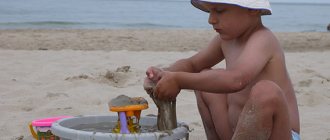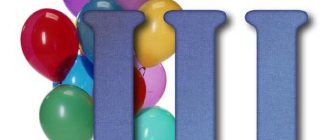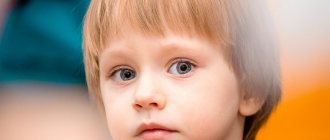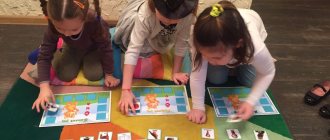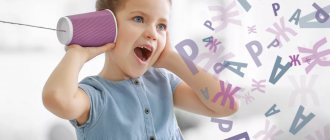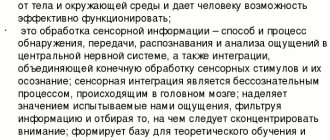Sensory alalia is a disorder in which a child’s speech does not develop due to a lack of understanding of the words of others.
This is a characteristic manifestation of disturbances in the functioning of the speech-hearing analyzer. As a result of a perinatal or postnatal complication, there is underdevelopment of some areas of the brain responsible for the perception and analysis of spoken speech.
With sensory alalia in children, in most cases, complete preservation of hearing is observed. Speech development does not occur due to the lack of connection between the sounds that the child hears and their meaning.
Symptoms of sensory alalia
The sensory alalik is not at all silent. Children have active—sometimes even overly—expressive speech. However, at the same time, they are absolutely not critical of their statements, not understanding themselves what exactly they are saying.
Characteristic features of sensory alalia:
- The mindless repetition of frequently heard phrases is echolalia. The child may persistently repeat advertising slogans, words of cartoon characters, etc. Sometimes speech may seem meaningful if the child repeats the last word he heard along with the answer. But if you change the phrase, there will be no result.
- Frequent confusion of words, syllables and phrases, the use of made-up words - the so-called logorrhea - is another characteristic symptom of sensory alalia.
- In most cases (about 70%), hearing remains intact. However, there is instability of auditory attention. In addition, many alaliks suffer from hyperacusis - increased sensitivity to certain sounds.
- Phonemic speech perception is impaired. That is, the chain through which auditory excitation is transmitted to brain structures associated with speech “does not work” in the child.
- There are also some memory impairments. In order to remember a word or phrase, alalik requires quite a lot of repetition.
So, speech with sensory alalia is absent not because the child has disorders of the auditory or speech or articulatory apparatus, but due to the inability to form a connection between the sound of a word and an object.
Treatment of sensorimotor alalia in children
Therapy for children diagnosed with sensorimotor alalia should be comprehensive, based on the individual characteristics of the disease in a particular child. It is also necessary to be systematic and attend classes regularly.
Treatment consists of medical, speech therapy, and psychological assistance.
The medical component of therapy consists of prescribing medications that stimulate brain metabolism and restore connections between neurons. Nootropics, multivitamins and other groups of drugs are used as needed. The course includes physiotherapeutic techniques (laser therapy, acupuncture, electrophonophoresis, electrical stimulation, magnetic therapy), massage.
Correction of sensory alalia
Classes to correct this condition are structured depending on its severity. A severe form of alalia, resulting from significant damage to areas of the brain, the child is completely unable to analyze sounds and, accordingly, understand the surrounding speech. A lighter state allows children to be aware of individual words, but not to isolate them in phrasal speech or, conversely, to perceive situationally remembered sentences and not understand words used independently.
To correct sensory alalia, a speech therapist must conduct an examination to correctly determine the severity of the condition and build a lesson plan that includes the necessary exercises and tasks.
Severe forms of this condition can lead to secondary mental and intellectual development disorders, so it is important to find a specialist who will help the child develop his speech.
Diagnosis of sensorimotor alalia in children
The diagnosis of sensorimotor alalia is made on the basis of an examination with the participation of a neurologist, speech therapist, otolaryngologist, psychologist, and pediatrician. If necessary, consultations with other specialists are prescribed. The purpose of diagnosis is to identify the exact cause of the defect and exclude other health problems that may be accompanied by speech disorders: autism, hearing loss, mental disorders.
To clarify the diagnosis and identify signs of brain damage, exclude space-occupying formations, and vascular problems, a small patient is referred to electroencephalography, vascular Doppler, MRI or CT.
Tasks and exercises for sensory alalia
Speech therapy classes are conducted as part of complex therapy. At the same time, given that the violation is systemic in nature, work is being carried out “on all fronts.” The classes necessarily include exercises for the development of motor skills, attention, memory, and phonemic hearing.
It is important to consider that for children with sensory alalia, uncontrolled sound sources only slow down the correction process, overloading the psyche and not having any speech impact. Therefore, the first thing the specialist recommends is organizing regular “quiet time” in the family and generally limiting the sound environment. Against such a depleted sound background, the child’s sensitivity to speech increases. This state is used during classes.
Treatment
Treatment of motor alalia is complex. The formation of speech skills is carried out against the background of drug therapy, the main purpose of which is to stimulate the maturation of brain structures.
Patients are prescribed nootropic drugs and vitamin complexes. Electrophoresis, magnetic therapy, laser therapy, decimeter wave therapy, transcranial electrical stimulation, acupuncture, electropuncture, and hydrotherapy are effective.
An important role in the treatment of motor alalia is given to the development of the child’s gross (gross) and manual (fine) motor skills, as well as memory, thinking, and attention.
Speech therapy correction of motor alalia includes work with all aspects of speech and includes not only classes with a speech therapist, but also regular specially selected exercises at home. At the same time, the child’s active and passive vocabulary is formed, work is carried out on phrasal speech, grammar, sound pronunciation, and coherent speech develops.
Speech therapy massage and logorhythmic exercises provide good results. With motor alalia, it is recommended to start teaching children to read and write early, since reading and writing help control oral speech and better consolidate the learned material.
Alalia are linguistic disorders of speech activity, i.e., symbolic, amodal, and not a direct consequence of pathology of the sensory or motor spheres.
Impressive (sensory) alalia syndrome is otherwise called a specific disorder of receptive speech development (F80.2 according to ICD-10). With this syndrome, a child without visible intellectual impairments, who has sufficient hearing, does not begin to understand spoken speech in time and, as a result, speak.
Diagnosing impressive alalia can be difficult. A number of authors [1, 2] indicate that sufficiently clear, unambiguous diagnostic criteria have not been developed for impressive alalia. Moreover, its very existence as an independent disorder is not recognized by everyone.
Children with alalia from the very beginning acquire language according to a pathological type, which distinguishes them from children with delayed language acquisition, in which language is formed later than usual, but according to the laws of the norm [3]. There are two main forms of the disease: expressive (EA) (motor) and impressive (IA) (sensory). Sometimes they talk about sensorimotor alalia, emphasizing that the clinical picture includes disturbances in both understanding and speaking. In our opinion, in almost every case, both impressive and expressive speech suffers. T.G. Wiesel [4] wrote that since expressive and impressive speech in a child are closely related, as a rule, with both forms of alalia, there is a deficiency of both types of speech activity. Moreover, with any of the forms, with motor alalia, secondary difficulties in understanding can be mild, and with sensory alalia, secondary disturbances in one’s own speech can be severe, even to the point of its absence.
Impairments in speech understanding in IA and EA, in our opinion, differ not quantitatively, but qualitatively. Thus, children with EA often have difficulty understanding grammatical structures. It is also difficult for them to distinguish by ear words that sound similar. At the same time, with severe EA and intellectual development disorders, understanding the general meaning of statements remains accessible [5, 6]. For I.A. characterized by a lack of understanding of the general meaning of statements, including the simplest everyday speech, as well as uncriticality of one’s speech. Similar disorders occur in the clinic of aphasia due to brain damage, but only in the acute period. Persistent impairment of speech understanding, similar to IA, is observed in Landau-Kleffner syndrome (LKS), according to ICD-10 F80.3.
The idea of alalia as a childhood analogue of aphasia, caused by brain damage in Broca's or Wernicke's areas, is not confirmed today in children with alalia: in the vast majority of cases, focal brain lesions are not detected. Conversely, children who had brain lesions at an early age develop not alalia [7-11], but childhood aphasia, i.e., disorders of formed speech that tend to quickly restore verbal communication [12, 13]. Recent studies of the formation of more complex language skills in this category of children at school age have revealed [14-17] the presence of certain impairments compared to controls, but in the light of our work, it is important what these children say. Based on these facts, it is logical to assume that alalia is not a manifestation of any residual damage to the child’s brain. In children with cerebral palsy, alalia is observed only in 3.8% of cases, although this may be due to diagnostic difficulties [18].
Various aspects of EA are presented in the works of a number of authors [1–3, 19]. The nature of brain damage in IA will be discussed further. Based on the clinical observations of N.N. Traugott and S.I. Kaydanova [20] came to the conclusion that in children with sensory alalia and aphasia (children’s sensory aphasia, which the authors call SLC), the higher speech areas of the brain remain open, as in adults with sensory aphasia, the formation and consolidation of conditioned connections to sound is selectively impaired irritants with the formation of “functional inferiority of the higher levels of the auditory system or central hearing defect.” The authors proved that the defect in auditory function in IA cannot be reduced to a violation of physiological hearing.
The diagnosis of IA can be made based on observation, with the main symptom being the absence of speech understanding at the age of 18 months without significant reduction in physiological hearing and visible impairment of intelligence. Speaking about IA, one cannot help but draw a parallel with the well-studied SLE, which is interpreted as dysfunction of the temporal regions of the brain due to epileptiform activity [21–25]. In SLS, a previously normally developing child loses the ability to understand spoken speech and, consequently, to speak. Hearing and non-verbal intelligence are not affected. Loss of language ability can occur gradually, but more often it occurs suddenly. The average age of onset of the disease is 3-7 years. Numerous studies of CLS confirm the connection, in many cases direct, between cognitive impairment and epileptiform activity [26–30]. At the onset of SLS, there is not always a clear connection between changes in the EEG and speech regression: one event may precede another by a period of several months to 2 years. In adolescence, the EEG normalizes, but this is not always accompanied by the restoration of cognitive functions. In 2/3 of sick children, a pronounced defect in speech function remains, 1/3 completely recover.
The clinical manifestations of LSK with onset in preschool age and IA are almost identical and differ only in a vague age limit (before the appearance of speech - alalia, loss of formed speech - LSK). Moreover, these are the only known syndromes in which the leading symptom is a persistent misunderstanding of spoken speech. The work mentioned above [20] showed the identity of the disturbance in the formation and consolidation of conditioned connections to sound stimuli in IA and SLS. Diagnosis of SLS is based on EEG examination data. Moreover, SLS can act not only as aphasia, but also as alalia [26, 31—34], i.e., there is no doubt that some cases of IA are associated with pathological changes in the electrical activity of the brain. At the same time, not all cases of IA show abnormalities on the EEG. This gives reason to assume the possibility of brain dysfunctions of different nature, which manifest themselves in a similar clinical picture, i.e., with different etiologies, symptoms of prolapse are common due to the involvement of the same regions of the brain.
The question of what primarily suffers in IA, auditory gnosis or auditory agnosia, inevitably leads to severe underdevelopment of the language system, since at an early age the formation of gnostic and linguistic functions is closely related.
Impressive vocabulary in healthy children develops from 9-10 months [35]. At this time, the child begins to relate what he hears to relevant objects and situations. An active vocabulary begins to form between 10 and 18 months. In the case of IA, the child does not begin to understand the speech of others, an impressive vocabulary is not formed, and therefore conversational speech does not develop. At what point speech understanding is impaired in IA is unclear. At an early age, children behave appropriately to the situation, their behavior is guided by facial expressions, gestures, intonations of adults or they copy the behavior of their peers, and parents most often claim that their child “understands everything, but does not speak.” N.N. Traugott [6], describing the behavioral characteristics of children with IA, believes that their general pattern of behavior does not differ from their normal peers, they are proactive, and quite sociable.
We analyzed the symptoms and course of the syndrome in 17 children aged 2 to 10 years, some of them we describe below.
Observation 1
Boy, 3 years 5 months, sees a speech therapist for the first time. Entering the office, I rushed to the manuals that do not require verbal understanding (boards with slots for different figures), and began to collect them. He did not respond to questions and requests. However, when the teacher managed to turn the child to face him and point to the lamps on the ceiling and the switch, he realized that he was being asked to turn on the light and rushed to carry out the assignment. When they gestured to the table where there was a bear, a ball and a hare, and asked for the bear, he headed towards the table and stopped indecisively. He looked back at the adults, as if asking what exactly should be brought, and, not understanding the instructions, took all three toys.
The above example shows that children with uncomplicated IA at the age of 2-3 years do not understand the simplest verbal instructions and do not know the names of objects, but they understand gesture instructions and readily carry them out, communicate with gestures and generally behave like healthy children who are in unfamiliar language environment.
The general and speech behavior of children with an uncomplicated form of IA aged 4 years and older is characterized by high speech activity, contact, echolalia and the ability to name when they are unable to recognize the same word by ear.
Observation 2
Girl, 4 years 1 month, from a Russian-speaking family living in Germany. Entering the office for the first time, she extended her hand, smiled and uttered a long, inarticulate “phrase.” Interrupting the mother, she began to explain something, but the child’s speech was a “speech salad” in which syllables and whole words could be heard. She often answered “yes” to questions without understanding them. Of the six subject pictures, I was able to show only one by name. She pointed to the picture several times and clearly pronounced “dog” syllable by syllable, but after a few minutes she could not show this picture by name. When called by name, she turned around (perhaps this was a reaction to the vocative intonation). The parts of the face on the doll are readily shown, but only in the sequence “eyes, nose, mouth.” When the sequence changed, she could not show it, i.e. she did not understand these words. Instead of “legs” she showed “nose” twice, instead of “jacket” - “duck”, i.e. the child has already begun to focus on auditory perception, but the auditory image of the word is still inaccurate and approximate. Repetition: vowel sounds, syllables and simple words were sometimes repeated correctly, but more often with distortions. I enjoyed drawing. While drawing, she did not answer questions, but repeated them like an echo.
It is typical for children with IA not to pay attention to verbal messages and not to look at their name. At the same time, they react to slight noise outside the window, quiet steps along the corridor, etc. This distinguishes them from children with hearing loss.
After 3 years, children with IA often begin to point to pictures themselves and listen to the answer. This behavior probably reflects both the child's developing cognitive activity and a response to the actions of adults who have repeatedly attracted the baby's attention by pointing to an object and naming it. If parents are attentive and support the child’s activity, then soon we can expect that the meaning-sound connection for the first words will be established. Some children with alalia initially understand words and can only identify them by name if they are spoken by a familiar voice.
Children with IA often say something, accompany the games with “speech”; in the flow of their “speech” you can sometimes hear fragments of words and whole words, in some cases - only fuzzy sounds. This “speech” has no meaning, but melodically resembles phrasal speech. N.N. Traugott [6] draws attention to the similarity of the “speech” of children with alalia with the speech production of adult patients with sensory aphasia, which is called “word salad.”
This symptom in patients with sensory aphasia can be observed only in the acute period of the disease; later, criticism of one’s speech is restored. The first meaningful words are usually the names of objects. Feature I.A. - active vocabulary exceeds passive - is associated with inferiority and instability of auditory perception: the child can name an object, therefore the sound-meaning connection is established, but when perceiving a familiar word by ear, it is not always recognized. The most important role in the process of understanding speech in such patients is played by voluntary attention: if the child is “switched on,” he performs tasks.
The phenomenon of echolalia is well known in IA. It usually manifests itself as a repetition of a question addressed to the child. Sometimes the child repeats only those questions that are addressed to him, as if trying to answer, and in some cases he spontaneously repeats everything he hears around him. Echolalia disappears if the child begins to understand the speech of others. In some cases of IA, there are pronounced articulation disorders; labial sounds (M, P, B) are more often affected.
Some children repeat questions addressed to them very quickly and only after saying the question do they understand the interlocutor. In this case, an adaptive system of understanding probably develops, in which repetition and pronunciation play an intermediate role.
N.N. Traugott [6] described a situation where a person suffering from alalia understood and followed verbal instructions if the reward for the answer was candy, which the boy liked, but ceased to understand if the type of candy was changed. As a result of the research, she came to the conclusion that the child understood the addressed speech when he wanted. A.L. Bitova and E.N. Safronova [36] note that a child with sensory alalia does not use hearing at all or uses it under conditions of overmotivation, when the child really needs to understand something. Their parents also describe the behavior of children with IA: the child either understands speech or behaves like a deaf person. In our opinion, in children with IA, involuntary understanding of the speech of others is impaired or later formed, which ensures the development of their native language. Voluntary understanding becomes possible after 3 years. Later, when the child already has some vocabulary, the dependence of understanding on voluntary attention is clearly visible.
There are different variants of the course of IA.
Spontaneous compensation of the defect. In this case, at some stage of development, the child begins to understand the speech of others, an impressive vocabulary develops, and then the formation of spoken language occurs. In this way, IA syndrome is similar to SLS. In all cases of IA known to us, when involuntary understanding of speech at some point became possible, and one’s own speech began to develop (4 patients out of 17, i.e. 23.5%) and the clinical picture of speech underdevelopment acquired features of one form or another EA.
Observation 3
Boy, 3 years old, from a Russian-speaking family living in Germany. The anamnesis is not burdensome. Parents note lack of speech; hearing is normal.
Severe IA: the child did not comply with verbal requests, did not speak, did not repeat, and accompanied the game with quiet babbling. He understood and followed gesture instructions. Behavior is adequate, calm, assiduous.
Examination six months later: he easily understood many questions: “what is your name,” “what is the name of your mother and brother,” and answered them. Showed body parts and surrounding objects by name. He immediately turned around when his name was called. I listened to a story based on a series of pictures. Passive vocabulary is poor. He answered questions and expressed desires, usually in one word. If words were not enough, he used gestures. Expressive alalia was diagnosed. Subsequently, the boy studied with a Russian speech therapist. He began to speak in phrases; the most persistent symptoms of speech underdevelopment were agrammatism (speaking without endings) and insufficiency of auditory-verbal memory. The boy attended a German kindergarten and mastered the German language. They spoke Russian at home, meaning the boy became a natural bilingual. At the age of less than 7 I went to a German general school, and in the first grade my academic performance was normal.
Observation 4
Girl, 3 years 11 months, from a Russian-speaking family living in Germany. Hearing is normal. At the time of examination, she spoke individual words, rarely phrases of 2-3 words, the vocabulary was poor and covered only the most necessary everyday concepts. She spoke without endings, her pronunciation was unclear. At the same time, the girl demonstrated good cognitive activity: she carefully looked at books with pictures and easily put together puzzles; At the same time, I didn’t want to listen to the story from the pictures, I tried to understand the plot with my eyes. She often did not respond to verbal requests; echolalia.
Positive dynamics were noted during the classes. After 1 year, the girl demonstrated satisfactory understanding of speech in the process of completing tasks, but it was almost impossible to attract or switch the child’s attention with verbal instructions, auditory attention remained reduced: the question had to be repeated several times. Agrammatisms persisted. The pronunciation became intelligible, only individual sounds (L, R, CH) were distorted. Later, the girl began to attend a German kindergarten, and at the age of 6 she went to a German general school. Natural bilingual. She studied with a German speech therapist and noted pronounced agrammatisms.
The above clinical observations suggest that with IA there may be a delayed development of the function of involuntary speech understanding. The “turning on” of the function of understanding occurs, apparently, gradually, and for a long time it can remain a weak link, subject to exhaustion. After speech understanding becomes available, the picture of its underdevelopment takes on the features of E.A. The most persistent symptoms are impressive agrammatisms, inability to distinguish close-sounding phonemes and insufficiency of auditory-verbal memory. Involuntary understanding of speech remains inaccessible; the child is forced to rely only on voluntary understanding.
After 3 years, there comes a time when the child begins to point to objects or pictures, as if asking - what is this? And listens to the names. At this moment, voluntary attention is activated and the meaning-sound connection can be established.
Observation 5
Boy, 4 years old, from a Russian-speaking family living in Germany. Parents' complaints about their child's lack of speech. Hearing is normal. History of complications during childbirth. The mother demonstrated the child’s understanding of several words: the boy showed pictures in the book by name. However, he did not respond to questions or calls by name, could not point out objects in the office by name, or choose one of the three proposed toys. The child was calm, assiduous, and performed tasks that did not require verbal understanding. He communicated with gestures and quiet exclamations. He repeated the vowel sounds A, I. He could not repeat syllables and words. Diagnosis: impressive alalia.
Subsequently, the child studied with speech therapists, attended a German kindergarten, then a German general school, but did not master the German language. The boy's parents transferred him to a school for children with developmental disabilities. I understood only a few German words that I learned at home. When examined at the age of 10, he quickly and quietly repeated questions asked of him and then answered. He answered only the simplest questions without repetition. In many cases, after repeating the question, I could not answer (for example, the question: what floor do you live on?). While listening to the questions, I looked carefully at the interlocutor’s face. The boy had a fairly extensive vocabulary and could name pictures that depicted one action. It was not possible to compose a story from a picture depicting several characters. Could list items belonging to a certain category. The pronunciation is clear, but there are substitutions of sounds, most often deafening of voiced consonants. I tried to use gestures to communicate; only at the persistent request of adults did I use memorized phrases.
Observation 6
Boy, 9 years 5 months, from a Russian-speaking family. He spent the first years of his life in Russia. The child did not speak on time, but speech therapy classes were not conducted. According to the mother, behavioral disorders gradually became so pronounced that she was afraid to leave the house with her son. When the child was 8 years old, the family moved to Germany, and the boy began to attend a school for children with reduced intelligence, but by this time his behavior had returned to normal. At school I began to learn German. During the examination: the boy did not pay attention to verbal addresses, did not react to vocative intonation, but non-verbal contact was good, the child readily completed tasks. When concentrating, he could show some objects by name; the passive vocabulary is extremely poor. To communicate with the family, I used several Russian phrases - when pronouncing them I was unsure, agrammatisms were noted, many sounds were distorted.
In the last two cases, there was no spontaneous development of the function of involuntary speech understanding. Probably, in the case when involuntary understanding of the speech of others becomes possible even in the preschool period, one can expect delayed but full-fledged language acquisition. A later “switching on” of understanding may not lead to a noticeable improvement in language function, since over time, thanks to plasticity, an adaptive functional system of speech understanding develops (for example, through repetition of a question). In addition, the ability to acquire a language declines with age. The child must be immersed in a language environment (meaning the first language) no later than 5-7 years, otherwise there may not be full language development [37, 38].
The table compares the main characteristics of language acquisition by healthy children and children with AI.
Comparison of language acquisition in healthy children and children with IA
Mastering a native language is a natural state of a developing individual, i.e., this process develops as an independent behavior [9, 39]. Speech understanding during language development in healthy children always precedes speaking skills [35]. Undoubtedly, this understanding is involuntary. The most important feature of mastering one’s native language is the path from understanding entire statements to understanding individual units of language. So, L.S. Vygotsky [40] wrote that the child begins with the whole in the development of the semantic side of speech and only later moves on to mastering particular semantic units, individual verbal meanings. The first words that a child utters can be considered in meaning as equivalent to phrases [41]. The literature [19] emphasized that language is not a disparate set of units, but a complex of interacting processes that allow it to act as an integral system.
There are two ways of mastering a language - natural (this is how the first native and subsequent languages are mastered when immersed in a living language environment) and learning in a logical way (the result is a foreign language). Both methods interact in healthy people and allow the acquisition of new languages in different conditions and at different ages, but can also function independently. The features of learning a foreign language coincide with the features of language acquisition by children with a severe form of I.A. A child with IA cannot master the language on his own and without proper pedagogical support he remains without it. For comparison: with EA without pedagogical assistance, language acquisition is possible, only individual elements suffer.
Studies of the role of genetic factors in the etiology of underdevelopment of oral speech [1] show that they play the greatest weight in cases of selective, uncomplicated forms of underdevelopment of expressive speech (EA), which usually lead to impairments of moderate severity with a relatively favorable prognosis for compensation.
The idea of IA as a disorder in which it is impossible to master a language as a native language, but it is possible to study it as a foreign language, is, according to our observations, very productive. This idea provides a certain basis for planning pedagogical assistance to children with this syndrome, on which specific methodological techniques can be built that are appropriate to the age and characteristics of the child. This idea also helps parents understand the logic of this syndrome and the difficulties experienced by the child, which is necessary for organizing classes at home.
When organizing pedagogical assistance, the issue of using the auditory modality is controversial. In the auditory modality, work should be based on voluntary auditory attention, which is preserved in this syndrome. In this case, it is necessary to take into account the exhaustibility of voluntary attention and use other, intact analyzers.
Diagnosis of IA is difficult for a number of reasons. Firstly, it is possible to verify whether a child understands speech or not only by the child’s external manifestations and behavior. However, a healthy child of 2-3 years old may not turn around when called by name because he does not want to communicate with this person, is shy, or is completely absorbed in the game. Impaired communication ability is observed in autism spectrum disorders. With severe behavioral disorders, which can be either isolated or accompanied by IA, it is very difficult to establish non-verbal contact with the child; this sometimes requires several meetings. Therefore, in our opinion, the most important condition for diagnosing IA is reliable contact with the child on a non-verbal level. It is the difference in the execution of verbal and non-verbal commands that serves as a diagnostic criterion.
Differential diagnosis of IA and hearing impairment is described in detail in the works of N.N. Traugott [6, 20], as well as L.G. Paramonova [2]. Assessing speech understanding in children in multilingual environments is especially difficult. As a rule, children 2-3 years old who are in contact with several languages know some words and commands in one language, and some in another. In a multilingual environment, one can often observe the phenomenon of non-pathological erasure of language ( English:
language attrition): a child easily forgets one of the languages if the intensity of communication in it decreases. However, a healthy child never loses the ability to verbally communicate: he either changes one language to another, or becomes monolingual from bilingual. When diagnosing language impairment in a multilingual environment, it is advisable to test all languages with which the child is exposed. Many observations of the development of speech in healthy children in a bilingual environment record one or another delay in language development during the transition to phrasal speech. It is very difficult to understand what is causing the lack of language development in these cases.
Differential diagnosis of IA and early childhood autism is often difficult. According to H. Amorosa, M. Noterdaeme [42], such a diagnosis is impossible at an early age, but later, as the child develops, it is not difficult. Often the same non-speaking child of 2-3 years old makes a different impression on different days. Moreover, even during one lesson, the child’s condition may change.
With IA syndrome, involuntary speech understanding, which is normally the basis for mastering the native language, is impossible due to a pathology of unknown origin. At the 4th year of life, voluntary understanding becomes possible. For healthy children, voluntariness is an additional tool in understanding the world and language, and for children with IA it is the only possible way to understand the speech of others.
Summarizing the analysis of the literature, clinical observations, as well as the results of comparison of symptoms, course, outcomes and dependence of language syndromes on the age of children [43], we can draw the following conclusion: many cases of IA are based on functional brain damage. In essence, dysfunction is a pathological process that does not destroy the brain, but complicates or makes impossible the functioning of its individual regions and the normal development of cognitive functions. Clinical manifestations depend on the area of the brain affected by dysfunction and, apparently, can be similar when exposed to various pathogenic factors. In the development of speech pathology in dysfunctional disorders, the intensity of the pathological process can play a greater role than its localization. S.B. Buklina et al. [44] noted that in epilepsy, not only focal “disconnections” of functionally significant areas are possible (for example, leading to the appearance of aphasia), but also a global restructuring of functional systems. Dysfunctional disorders can lead to permanent impairment of speech and other cognitive functions. At the same time, spontaneous restoration of impaired functions is possible. The prognosis depends on the duration of the pathological process. Plasticity in dysfunctional disorders manifests itself either as the elimination of dysfunction (the functioning of the affected regions spontaneously normalizes, cognitive functions are restored) or the formation of workarounds for verbal communication (for example, understanding speech through repetition in IA).
We make assumptions about the possible dysfunctional nature of IA based on: 1) the persistence of IA symptoms; 2) the identity of the symptoms, course, and outcomes of IA and SLK, the dysfunctional nature of which is known; 3) differences in symptoms, course, outcomes and age dependence from childhood aphasias due to damage to the brain substrate and SLC [43].
In some cases of IA, it can be assumed that there is a disruption in the maturation of brain structures responsible for the formation of language. The cause may be pathology of the pre-, peri- and postnatal period. In these cases, the nature of the course of the syndrome - a consistent improvement in auditory perception - is closer to the course of syndromes due to pathology of the brain substrate. Suggestions have been made [4] about the connection between the pathology of the corpus callosum and I.A. syndrome. Perhaps the plasticity of the brain, which is so clearly manifested in cortical brain lesions, does not extend to subcortical structures.
“Language Bridge” is a public, non-profit organization whose goal is to promote German-Russian bilingualism, as well as language therapy.
The second stage - the first forms of words
At this stage, children are taught to combine words into a two-word phrase . Here they also do not correct children’s words, preferring that children combine them in their “original” form.
Adem amo - let's go home, baba kusya - grandma eats. Children are taught to pronounce words of 2, then 3 syllables, emphasizing the stressed syllable (cotton wool, kitty, fly, water, fox, cubes, milk, car).
Children give commands to toys or peers, loved ones (go, sit, sing, eat, mine, help), combine an address and a verb in one phrase (Masha, catch. Kolya, go).
By the end of this stage, children are able to construct sentences from two words, can correctly pronounce words of two and three syllables, correctly placing stress, and answer questions about the picture, showing the correct answer.
The fifth stage is expanding the volume of supply. Difficult sentence
At this stage, children are taught to coordinate adjectives and nouns, select definitions for objects, memorize poems of 4-6 lines, and compose sentences with homogeneous members.
After mastering these skills, children are taught to compose complex sentences using games:
- "What's first, what's next."
- “Guess where I made a mistake.”
- “I don’t know what I’ll do.”
- “Tell me why you chose this toy.”
- "And what do you want?".
- “What did they tell you on the phone?”
By the end of this stage, children's speech becomes grammatically correct, although some inaccuracies are acceptable. Next comes work on improving speech and teaching more complex forms.
The painstaking and long-term work of a speech therapist with the support of the child’s parents will certainly lead to a solution to the problem - teaching a child with motor alalia correct and beautiful speech.
It is important to remember that this process requires patience and time, combining the efforts of a speech therapist, a teacher-psychologist and the child’s parents.
The third stage is the construction of a two-part sentence
This stage is considered a kind of turning point: the speech of some children begins to develop rapidly, while in others all manifestations become protracted.
If a child does not feel the grammar of the language, he is offered the following tasks:
- Distinguishing words that differ only in one sound (log-knee).
- Distinguishing between verbs that are similar in sound (carry-carry, hang-stand).
- Distinguishing actions that are opposite in meaning (fasten and unfasten).
- Determining the person who performed the action (Sasha fell, Sasha fell).
- Working with prepositions in, over, behind, under, before, from under.
- Distinguishing adjectives with opposite meanings (big - small, thick - thin).
To teach children to compose sentences, they are asked to match the name of the object to the action, compare plot pictures where the actions are performed by one or more persons. Children finish words and phrases in poems.
To master the syllabic structure of words, children are taught to divide words into syllables by tapping the syllables or clapping them.
By the end of this stage, children are able to coordinate the subject and predicate in a simple sentence, master the syllabic pattern of two- and three-syllable words, and understand the content of short fairy tales and stories.
How does a speech therapist organize the learning process?
Such classes are most productive if they are conducted individually.
If a group of children , then it should not be more than 3 people.
All tasks are offered only in a game form , and at the beginning of the work, most tasks do not require speech.
These techniques are aimed at:
- To develop memory and attention;
- For the development of fine and gross motor skills;
- To develop thinking;
- To develop ideas about the shape, color and size of objects.
At the same time, the speech therapist carefully observes the child , what speech manifestations are available to him, what is the level of speech understanding, whether there are phrases in everyday life, how many words he can pronounce independently.
It is very important to establish close emotional contact with the child so that he trusts the teacher and does not become isolated. To do this, you need to encourage any, even the smallest achievements of the child.
A speech therapist does not have the right to force a child to say something or repeat after him if he has no desire to do so. It is quite possible that the words “say, repeat” were abused in the family, and the child has already developed a negative reflex, a negative reaction to them. The speech therapist will try to replace these words with others - for example, “tell me, guess.”
It is quite possible that he himself will ask and answer his own question. If onomatopoeia has become available to a non-speaking child, then it is allowed to repeat these sound reactions after him 1-2 times (me-me, aw-aw, bi-bi, meow, w-w-w).
The speech therapist is not recommended to repeat words distorted by children (drink - pi, bear - mi, dog - baka), since adults should set an example of accurate and correct speech.
A prerequisite for productive work is repeated repetition of the same speech material . Here the speech therapist has to use all his skills to make classes interesting for the child.
What should parents do if they suspect motor alalia in their child?
Stage four – multi-word sentences
At this stage, children are taught inflection , drawing their attention to the “end” of a word, asking them to answer an adult’s question in a complete sentence.
Now some part of the classes is devoted to sound pronunciation, preparing the articulatory apparatus for producing sounds.
Children are offered the following tasks:
- Answers to questions about the plot pictures.
- Carrying out instructions and reciting completed actions.
- Changing words by gender and number.
- Learning the ability to formulate a question.
- Memorizing couplets.
- Listening to short stories and answering questions about their content.
By the end of this stage, children master the elements of spoken language, it acquires a communicative function, and they can pronounce words of 3-4 syllables.
Why do you need to start classes as early as possible?
The age from birth to 5 years is a sensitive (most favorable) period for correcting speech disorders. The fact is that it is in early and preschool age that intensive formation of the brain and the development of its functions occur.
Why a child may not speak at 2 years old - 13 reasons
Physiological scientists believe that it is necessary to train the functions of the central nervous system when they are formed naturally. This makes them easier to train. And without appropriate support, the development of these functions may stall and even stop altogether.
The famous Russian physiologist I.P. studied the connection between speech and brain functions. Pavlov: “The mechanisms of speech are associated with the activity of the brain, hierarchical in its structure. Each of the links of which makes its own specific contribution to the nature of speech activity.”
His research was continued by such world-famous neurophysiologists as A.R. Luria, N.A. Bernstein, P.K. Anokhin.
The classic of Russian psychology L.S. Vygotsky showed that “...initially planning speech is external in its form, and then passes into the internal plane, becoming internal speech.”
Research by modern psychologists has proven that the speech and behavior of a child with underdevelopment of the regulatory function is distinguished by the following features:
- The actions of such children are impulsive.
- They don't notice their mistakes.
- Children are easily distracted and lose track of the “ultimate” task.
- They find it difficult to establish the sequence of mental operations.
- Children with speech underdevelopment cannot inhibit side associations.
When working with children diagnosed with “motor alalia,” a speech therapist cannot fail to take into account these distinctive features of their activity.

